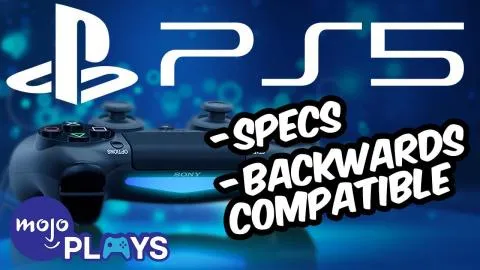Playstation 5 - The 5 Biggest New Facts and Reveals

The 5th generation of Sony consoles is coming, and no, it’s not a streaming platform. Welcome to MojoPlays, and this is everything you need to know about the PS5 So Far.
WIRED Magazine Senior Correspondent Peter Rubin sat down with Sony’s Mark Cerny, who previously served as the lead architect for the Vita and the PS4, to break down some of the things we can expect from Sony’s Next-Generation Console. Here’s everything you need to know.
Ray Tracing
With each new console generation comes new hardware that allows developers to push the boundaries of console gaming. In the case of Sony’s next console, it all starts with a CPU based on the yet-unreleased AMD Ryzen 3000. What we’re really excited about is the custom AMD Navi GPU which will allow for Ray Tracing. If you’re not familiar, Ray Tracing is a rendering technique that allows for image generation based simulating light in a virtual space. The simulated light interacts with the virtual environment As Rubin notes in his piece, this technique is usually reserved for Hollywood Blockbusters and less-so for video games, which have to render in real-time. Well, with a Graphics Card as powerful as the Navi, it opens up a new world of possibilities for gaming, allowing developers to create graphical images the likes of which we’ve never seen in a console game.
3D Audio
Mark Cerny notes that Ray Tracing isn’t the only innovation made possible by the Navi GPU. It also includes a 3D Audio unit that will allow for more detailed and immersive audio. According to Cerny, quote, “it's been a little bit of a frustration that audio did not change too much between PlayStation 3 and PlayStation 4. With the next console, the dream is to show how dramatically different the audio experience can be when we apply significant amounts of hardware horsepower to it.” So what does that actually look like? The answer is simply more nuance and detail, made possible by more processing power, which will provide a level of spatial immersion or presence, especially if you’re playing with headphones. This will both provide more creative possibilities in single player games, and add a level of strategy to multiplayer games as well.
8K Resolution
Sure, your TV may not even be able to reach 4K, but this is the not-too-distant future we’re talking about here. The PlayStation 5 will support 8K resolution, which may not affect you right now, but once 8K TVs become as ubiquitous as 4K is right now, you’ll be glad Sony had the foresight to make it possible. As the name implies, 8K resolution has twice as many vertical pixels as 4K or four times the resolution of 1080p. The future of console gaming -and home entertainment in general - is 8K, and right now, it seems Sony is leading that charge. Of course, it’s worth noting that Sony is also part of a larger effort to lead that charge in the world of TVs with their 8K Bravia Z9G Master Series.
Internal Solid-State Drive
SSDs are nothing new - there’s a good chance the device you’re watching this video on has one, and you can purchase an external SSD for your PS4 right now if you’re so inclined. Unlike Hard Disk Drives, SSDs don’t have a physical disk or any moving components. Keep in mind, this isn’t your typical SSD we’re talking about here. According to Cerny, the PS5’s internal SSD will have more raw bandwidth than even the current top-of-the-line PC models. What does this actually mean for gaming, though? In the article, Cerny uses 2018’s PS4 exclusive “Spider-Man” to show off how their top-of-the-line Internal SSD could change gaming. Running on the PS4 Pro, it takes Spidey 15-seconds to fast travel from one point in Manhattan to another, which is the time it takes for the game to load the new area that the Wall-Crawler will appear in. Then, on a Dev-Kit using the new SSD technology, the same fast travel takes only one-eighth of a second. In other words, this could be the end of loading as we’ve come to know it.
Backward Compatibility
With the announcements of Google Stadia and Microsoft’s xCloud, many have written that the future of gaming is streaming. While we may one day get to a place where streaming will take over completely, Sony isn’t ready to ditch physical game disks just yet. On top of supporting physical copies of games for the Next Generation, the 5th Generation PlayStation will also support backward compatibility. That means that, unlike the PlayStation 4, which cannot play PlayStation 3 game disks, the PS5 will support your old PS4 games. Streaming may one day completely replace the need for physical media, but it’s nice to know that while there are options out there for those who want to jump into streaming, the same can be said for those who want to hold on to their physical copies.
